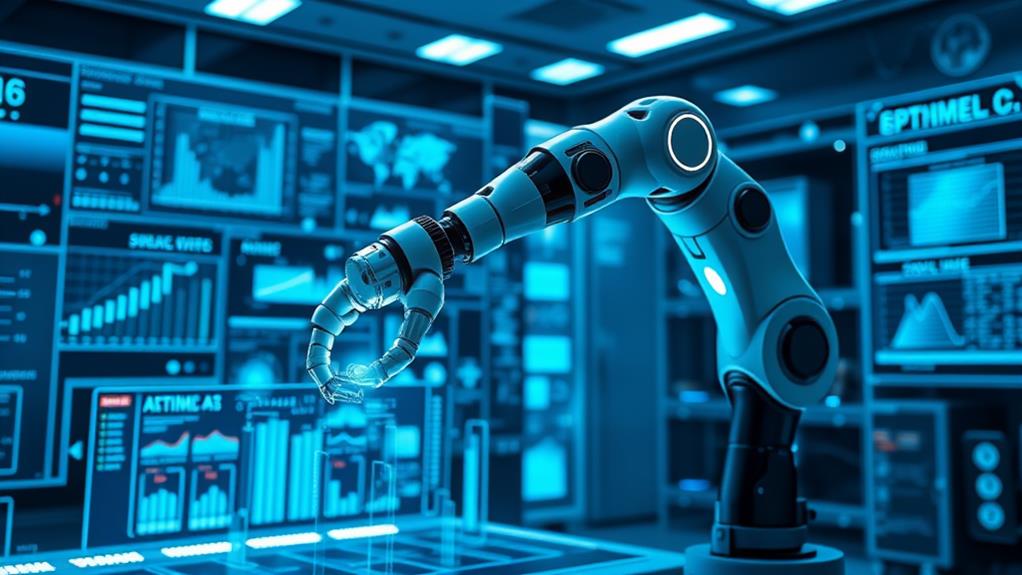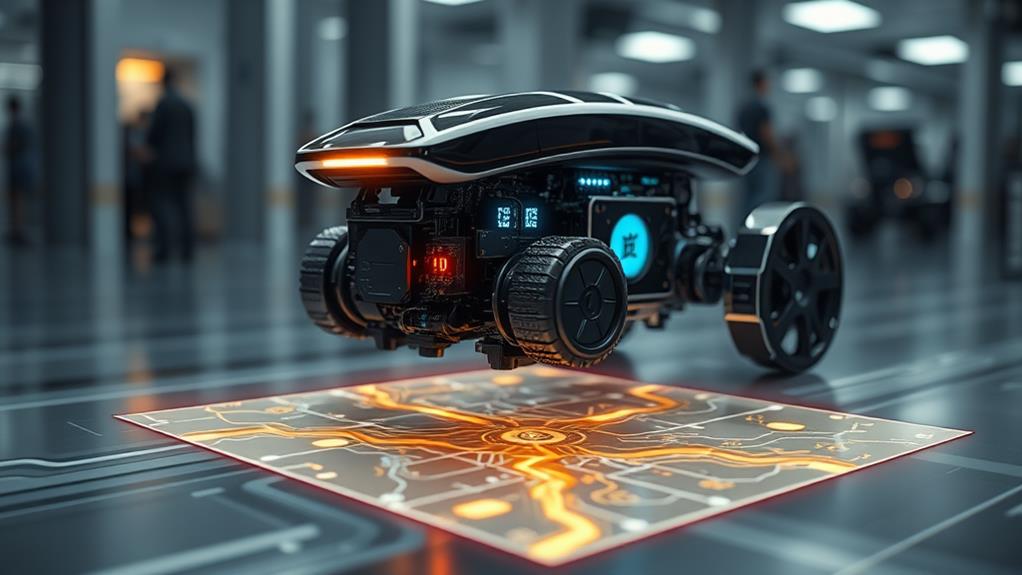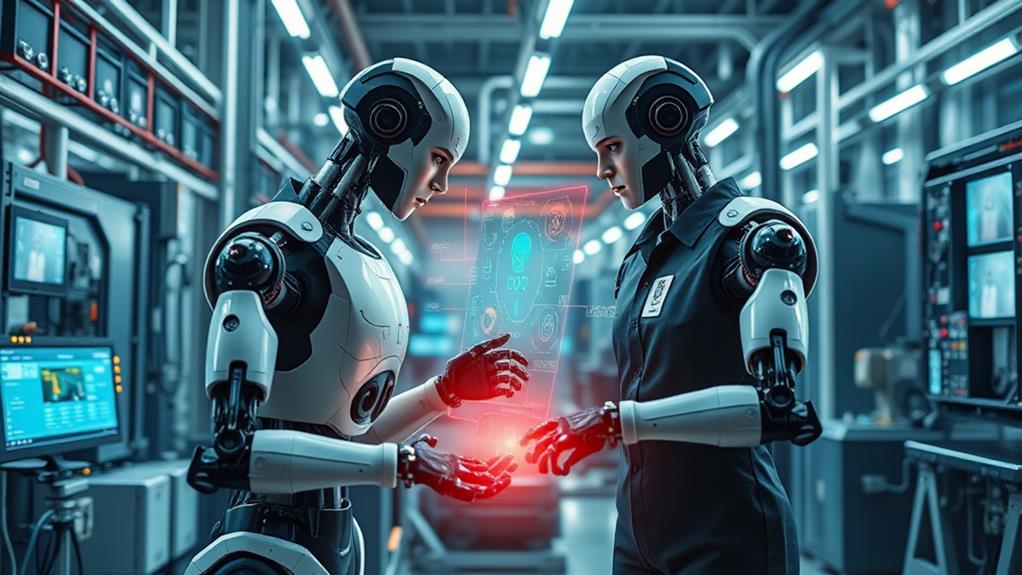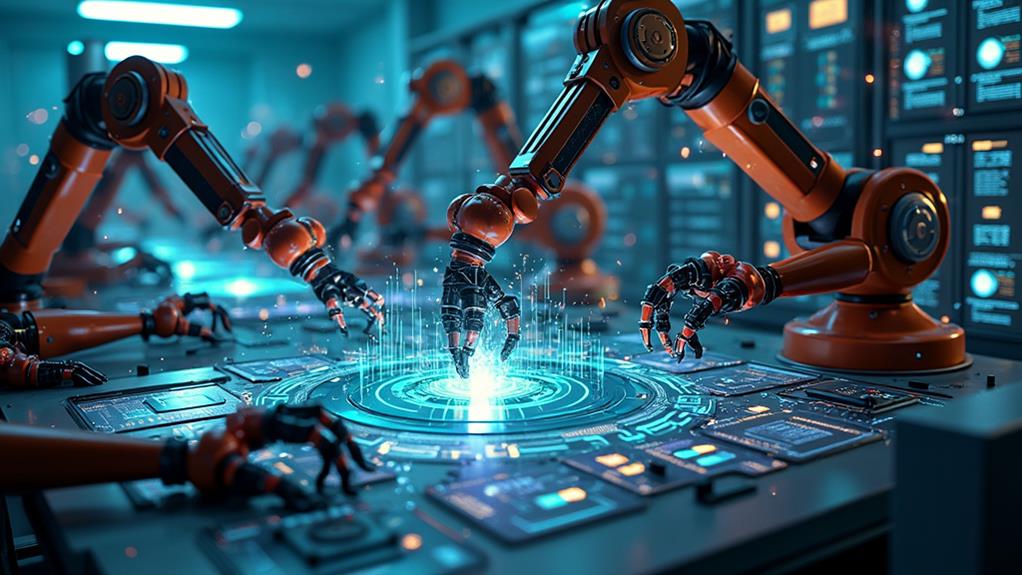Maximizing efficiency in robotics through intelligent systems is akin to giving robots a supercharged brain. Imagine them making split-second decisions by processing vast data, learning from past experiences, and dodging obstacles in real-time. AI-powered predictive maintenance slashes unexpected downtimes, saving big bucks on repairs. Energy efficiency? It’s through the roof, with smart systems reducing power needs by up to half. And let’s not forget the teamwork—collaborative robots boost productivity by working alongside humans safely and effectively. With these innovations, the future of robotics is not just efficient but thrillingly dynamic. Curious about the next step in this journey? Incorporating machine learning techniques for segmentation can further revolutionize robotics by enabling robots to identify and categorize objects with remarkable precision. This advanced capability enhances their ability to perform complex tasks with greater accuracy and efficiency, opening up new possibilities for applications in industries such as manufacturing, logistics, and healthcare. As we continue to explore the potential of intelligent systems in robotics, the possibilities for innovation seem truly limitless.
Table of Contents
Key Takeaways
- AI algorithms enable real-time data processing, reducing errors and optimizing decision-making.
- Predictive maintenance using AI minimizes downtimes and extends robotic equipment lifespan.
- Machine learning enhances task performance through continuous learning and operational pattern analysis.
- Collaborative robots (cobots) improve human-robot interaction, significantly boosting productivity.
- Energy-efficient systems and renewable energy integration lower operational costs and reduce carbon footprints.
Enhanced Decision-Making

In the domain of robotics, enhanced decision-making stands as a pivotal factor in maximizing operational efficiency. Imagine robots that aren’t just performing tasks but doing so with the precision of a chess grandmaster—thanks to AI algorithms. These intelligent systems process vast datasets in real-time, reducing errors and optimizing workflows. Think of it as robots getting smarter with every move they make.
Now, let’s talk about adaptive learning. This isn’t your run-of-the-mill learning curve; it’s machine learning at its finest. Robots analyze past experiences to improve their decision-making, adapting to changing environments and demands. It’s like having a seasoned pro who just keeps getting better.
Real-time path planning and collision avoidance further elevate this efficiency. Robots adjust their routes dynamically, minimizing travel times and boosting task execution speed. The result? Enhanced efficiency that any efficiency enthusiast would drool over.
Moreover, advanced decision-making capabilities optimize resource allocation, slashing operational costs by up to a whopping 50%. That’s not just a number; it’s a revolution in cost-effectiveness.
Put simply, these smart robots are transforming operational landscapes, making everything faster, cheaper, and undeniably cooler.
Predictive Maintenance
Leveraging the power of AI algorithms, predictive maintenance revolutionizes the way robotic systems operate by analyzing sensor data to preemptively detect potential issues. Imagine a world where robots not only perform tasks flawlessly but also know when they might falter, giving us a heads-up! This isn’t some sci-fi fantasy; it’s the reality of predictive maintenance. By predicting problems before they occur, we can greatly enhance operational uptime and keep our robots humming smoothly.
With predictive maintenance, organizations can reduce unexpected downtimes by up to 30%. Think about it: fewer breakdowns mean more productivity and less time (and money) wasted on emergency repairs.
How does it work? These intelligent systems use machine learning to refine maintenance schedules based on past performance data. It’s like giving robots their own little crystal ball! As a result, repair costs can drop by up to 25%, and the reliability of the robotic systems improves exponentially.
Moreover, this proactive approach extends the lifespan of our equipment by catching wear and tear early. So, not only do we cut costs and boost efficiency, but we also get more bang for our buck.
In short, predictive maintenance is the game-changer every forward-thinking organization needs.
Real-Time Path Planning

While predictive maintenance guarantees robotic systems remain operational by preemptively addressing potential issues, real-time path planning takes their efficiency to a new level by dynamically optimizing routing paths. Imagine a robotic warehouse assistant dodging obstacles and changing its path on-the-fly like a seasoned racecar driver—this is the marvel of real-time path planning.
AI algorithms are the brains behind this magic, processing data from an array of sensors to help robots maneuver through complex settings seamlessly. These advanced algorithms allow robotic systems to avoid obstacles and optimize operations, greatly enhancing efficiency.
And it doesn’t stop there. Continuous learning assures that these robots refine their strategies over time, adapting to ever-shifting layouts and workflows.
The integration of real-time path planning can lead to a reduction in travel times by up to 30%, a game-changer in industrial and logistics environments. By leveraging cloud computing, robots can process enormous datasets quickly, making informed decisions in the blink of an eye.
In essence, real-time path planning isn’t just a feature—it’s a revolution. It transforms robotic systems into agile, intelligent entities capable of maneuvering through today’s dynamic environments with unparalleled efficiency.
Data-Driven Performance
Data-driven performance is revolutionizing robotics by harnessing the power of predictive maintenance algorithms and real-time performance monitoring.
Imagine robots that can predict their own maintenance needs and adjust their actions on the fly—it’s like giving them a crystal ball!
With machine learning insights, these intelligent systems not only avoid unexpected breakdowns but also fine-tune their operations for peak efficiency, making them the unsung heroes in fields from aerospace to healthcare.
Predictive Maintenance Algorithms
Predictive maintenance algorithms have revolutionized the field of robotics by utilizing artificial intelligence to meticulously analyze sensor data, thereby enabling the early detection of wear and tear in robotic systems. This proactive approach not only prevents unexpected downtimes but also greatly reduces maintenance costs—by up to 30%, to be precise.
By leveraging AI, companies can continuously monitor robot performance, identifying patterns that optimize workflows and enhance operational efficiency. Imagine your robotic systems always functioning at peak performance, leading to superior results in logistics and other automated processes. It’s like having a crystal ball for your robots, predicting issues before they become costly failures.
Let’s break it down further:
| Advantages | Impact on Robotics | Real-world Outcomes |
|---|---|---|
| Early Detection | Prevents unexpected downtimes | Reduced downtime |
| Cost Efficiency | Lowers maintenance costs | Up to 30% cost reduction |
| Workflow Optimization | Enhances robot performance | Superior logistics results |
| Continuous Monitoring | Improves operational efficiency | 20% increase in productivity |
| Proactive Maintenance | Minimizes disruptions | Smoother automated processes |
Ultimately, predictive maintenance algorithms are not just a trend—they’re a game-changer. They empower businesses to maintain seamless operations, ensuring robots are always ready to perform at their best.
Real-time Performance Monitoring
Real-time performance monitoring, driven by sophisticated edge computing technologies, enhances the responsiveness and efficiency of robotic systems during operations.
Imagine a world where robots, with the aid of AI algorithms, can adapt their workflows on the fly, optimizing every move to perfection. By continuously collecting data, these systems can make immediate adjustments, reducing cycle times for tasks such as picking and sorting, and ensuring that everything runs smoother than a jazz band’s improvisation.
Performance metrics monitored in real-time are like having a personal coach for your robots. They help identify bottlenecks and inefficiencies, allowing operators to implement targeted improvements. This means less time wasted and more streamlined processes, making operational efficiency not just a goal but a reality.
But it doesn’t stop there. AI algorithms can predict maintenance needs by analyzing sensor data, effectively minimizing downtime and ensuring robots are always in top shape.
Leveraging big data analytics, these intelligent systems allow robots to adapt their strategies in real time to meet ever-changing demands. The result? Enhanced productivity in dynamic environments, and a step closer to a future where efficiency isn’t just maximized; it’s redefined.
Machine Learning Insights
Machine learning insights have revolutionized the way robotics systems operate, providing unprecedented levels of performance optimization and accuracy. In the bustling environment of modern warehouses, AI-powered robots are no less than superheroes, analyzing vast datasets to identify operational patterns that supercharge efficiency. These insights lead to smarter sorting and picking, with robots learning from past experiences and boosting productivity by a whopping 20-30%.
Real-time data processing takes things up a notch, enabling intelligent path planning and sophisticated collision avoidance. This means robots can navigate warehouses like seasoned pros, cutting down operational delays and optimizing travel routes.
| Feature | Benefit |
|---|---|
| Data Analysis | Enhanced operational patterns |
| Continuous Learning | 20-30% productivity increase |
| Real-time Path Planning | Reduced operational delays |
| Predictive Maintenance | 50% reduction in unexpected downtimes |
| Computer Vision | 99.9% picking accuracy |
Moreover, machine learning isn’t just about making robots smarter; it’s about keeping them running smoothly. Predictive maintenance powered by AI can forecast potential failures, slashing unexpected downtimes by up to 50%. And with computer vision, these robots don’t just see—they recognize objects with mind-blowing accuracy, exceeding 99.9%. Embracing machine learning in robotics is like injecting them with a dose of super-efficiency, turning the ordinary into the extraordinary.
Collaborative Robots

Collaborative robots, or cobots, are revolutionizing the modern workplace by enabling safe and efficient interaction between human workers and robotic systems. These AI-driven robotics marvels are designed with advanced safety features that prevent collisions and minimize workplace injuries, making them the perfect partners for human workers.
Imagine boosting productivity by up to 85%—that’s not sci-fi, that’s the power of cobots at work. They seamlessly integrate into existing workflows, requiring minimal modifications to the workspace, which means quick onboarding during peak demand periods.
But wait, there’s more! The flexibility in design of cobots allows them to adapt to a variety of tasks and environments, from assembling intricate electronics in manufacturing to sorting packages in logistics and even assisting in healthcare.
They work alongside humans, taking on repetitive or complex tasks that are too challenging for full automation but too monotonous for manual labor. Plus, regular safety assessments and training programs guarantee that both robots and human operators can work together efficiently and safely.
Fundamentally, cobots are not just machines; they are teammates, enhancing productivity and fostering a collaborative work environment where innovation thrives.
Energy Efficiency
In the quest for energy efficiency, optimizing power consumption in robotic systems proves to be a game-changer, slashing power use by up to 50% and cutting operational costs without sacrificing performance.
Smart energy allocation guarantees that every watt is used wisely, while integrating renewable energy sources adds a layer of sustainability, making our robots not just efficient, but eco-friendly too.
Imagine robots that capture wasted energy like a savvy couponer; these innovations make certain nothing goes to waste, increasing productivity and paving the way for a greener future.
Optimizing Power Consumption
Achieving ideal power consumption in robotic systems is an essential goal for enhancing both performance and cost-efficiency. Designing energy-efficient robots is no longer just a dream—it’s a dynamic reality. Imagine slashing power consumption by up to 50%, a feat that considerably lowers operational costs while maintaining exceptional performance. It’s like giving robots a turbo boost without the hefty fuel bill!
Modular robots are the superheroes here, with their adaptive designs that optimize resource utilization. These versatile machines adjust their energy needs based on task requirements, ensuring no watt is wasted.
Integrating AI-driven analytics into these systems takes it a step further by enabling real-time monitoring. It’s like having a personal trainer for your robot, constantly tweaking and improving its energy usage to keep it in peak condition.
Moreover, regenerative braking systems are a game-changer, capturing and reusing energy that would otherwise go to waste. This innovation not only minimizes power consumption but also extends operating time by 20-30%, leading to a productivity surge.
In the end, these advancements are not just about saving energy—they’re about pushing the boundaries of what robots can achieve, making the future of robotics as bright and efficient as ever.
Smart Energy Allocation
Smart energy allocation is pivotal in modern robotics, driving efficiency and performance to new heights. Imagine robots that practically think on their feet—or wheels—thanks to AI, adjusting their energy consumption based on real-time operational demands.
These energy-efficient systems can cut down power usage by an impressive 50%, transforming what once was a power-guzzling gadget into a lean, green, robot machine.
Regenerative braking systems are another game-changer, capturing and reusing energy that would otherwise be wasted. This clever tech extends operation time by a nifty 20-30%, making your robots work harder, longer, and smarter.
Then, we have modular robots, the Swiss Army knives of the robotic world. With their interchangeable parts, they can swiftly adapt to different tasks while keeping energy efficiency in check.
It’s like having a multi-talented athlete who excels in every sport they try—talk about performance!
Advanced energy management systems bring it all together, enabling predictive maintenance that guarantees energy allocation is spot-on.
No more unnecessary power waste; just streamlined, efficient operation.
Renewable Energy Integration
Integrating renewable energy sources, such as solar and wind, into robotic operations marks a significant leap towards sustainable and efficient manufacturing.
Imagine slashing operational costs by up to 50%—yes, that’s what renewable energy can do for robotics. It’s not just about saving money; it’s about propelling us into a greener future.
Energy-efficient robotic systems are the stars here, equipped with regenerative braking technologies that capture and reuse energy, extending operational time by 20-30%.
But wait, there’s more! These innovations don’t just lower our carbon footprints; they align perfectly with sustainability goals, transforming the manufacturing landscape.
Let’s break down the benefits:
- Reduced Operational Costs: Renewable energy sources can cut energy expenses by up to 50%.
- Enhanced Efficiency: Regenerative braking technologies in robots minimize waste and boost operational time by 20-30%.
- Sustainability: Lowered carbon footprints align with global sustainability goals.
- Real-Time Monitoring: Advanced energy management systems guarantee robots operate at peak efficiency.
Collaborative robots (cobots) with energy-efficient designs are the icing on the cake, seamlessly integrating into workflows and enhancing productivity.
Frequently Asked Questions
How Can Robots Increase Efficiency?
Robots increase efficiency through task automation, process optimization, and workflow enhancement. Real-time monitoring and predictive maintenance guarantee resource management, reducing downtimes and extending operational lifespan, while maximizing productivity and accuracy in various industry sectors.
Does Artificial Intelligence Increase Efficiency?
Yes, artificial intelligence considerably increases efficiency through AI applications such as machine learning, which enhances decision-making and predictive analytics, leading to automation benefits and process optimization, ultimately streamlining operations and reducing errors in various industries.
How Artificial Intelligence Can Improve the Way Robots Operate?
Artificial intelligence enhances robotic operations through robot learning and adaptive algorithms, optimizing tasks and ensuring predictive maintenance. Sensor integration and data analysis facilitate real-time decision-making, improving accuracy and efficiency across various industrial applications.
What Is Robotics and Intelligent Systems?
Robotics involves designing and operating various robot types using advanced sensor technology and programming languages, offering significant automation benefits. Intelligent systems drive innovation, addressing ethical considerations and future trends, enhancing efficiency and adaptability in dynamic environments.
Conclusion
In summary, integrating intelligent systems into robotics can greatly boost efficiency across various domains. Enhanced decision-making, predictive maintenance, real-time path planning, data-driven performance, collaborative robots, and energy efficiency collectively contribute to a more advanced and reliable robotic workforce. These innovations not only improve productivity but also guarantee sustainable and future-proof operations. Embracing such technologies will pave the way for a new era of robotics, characterized by unparalleled precision and adaptability.






